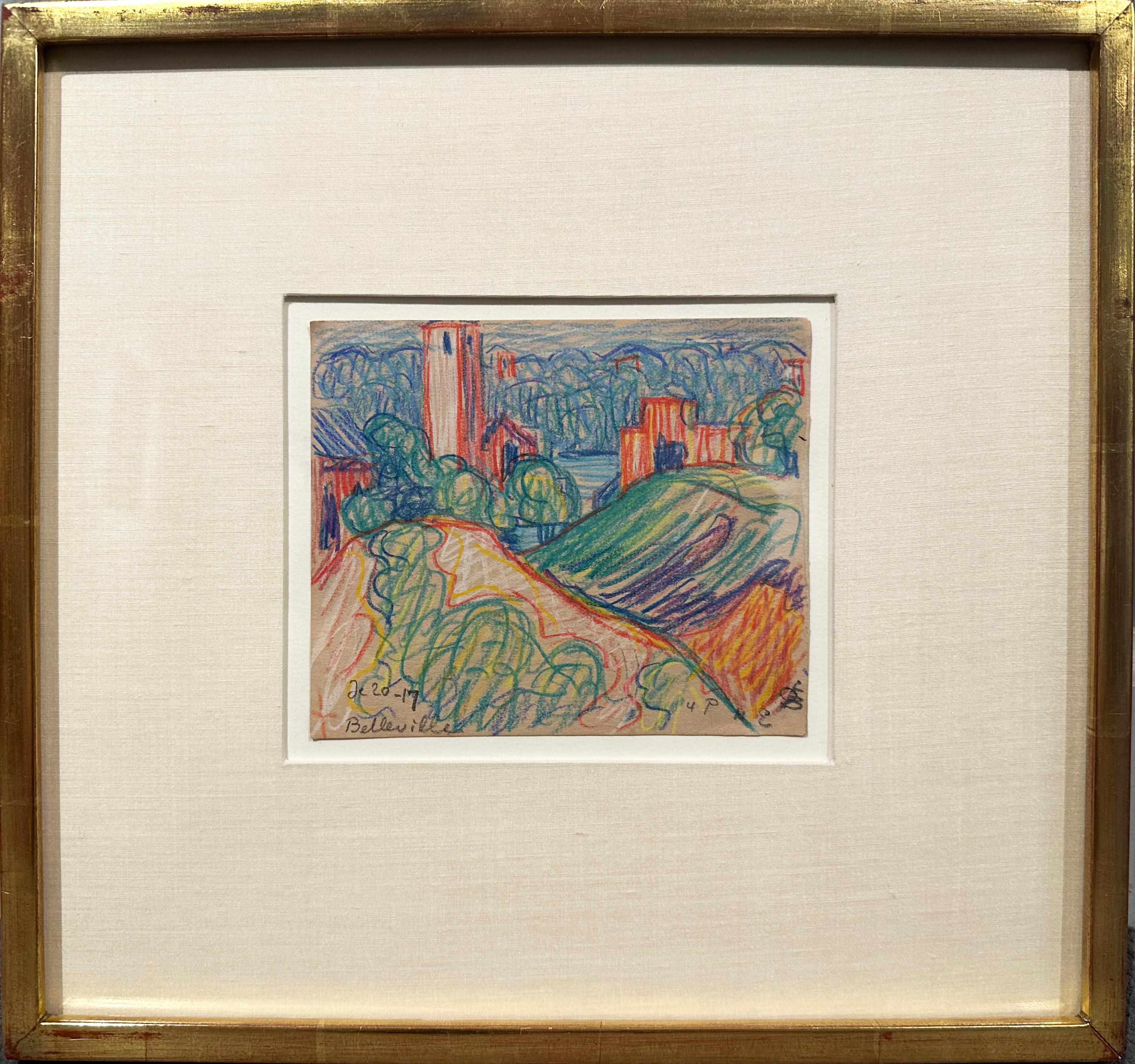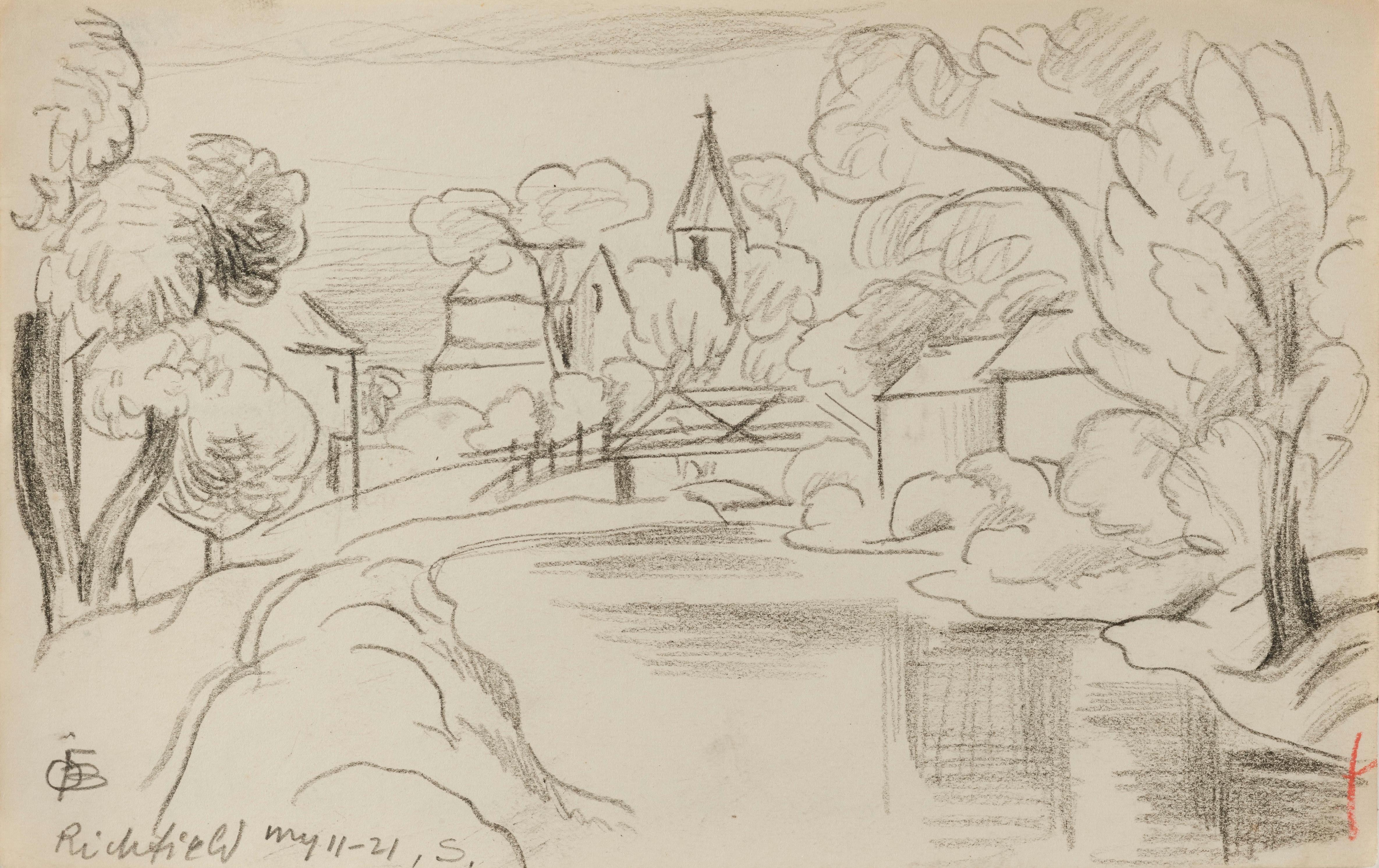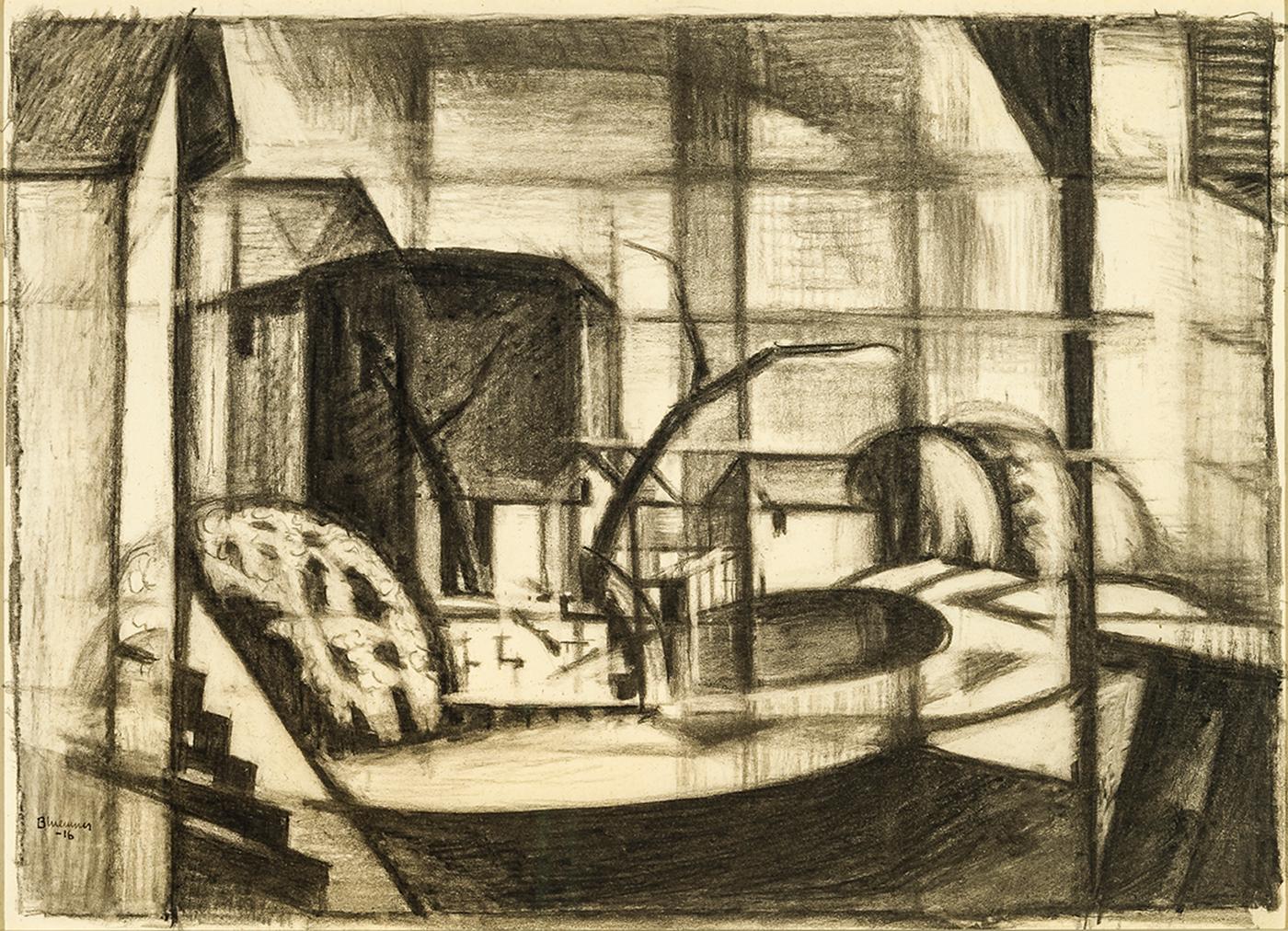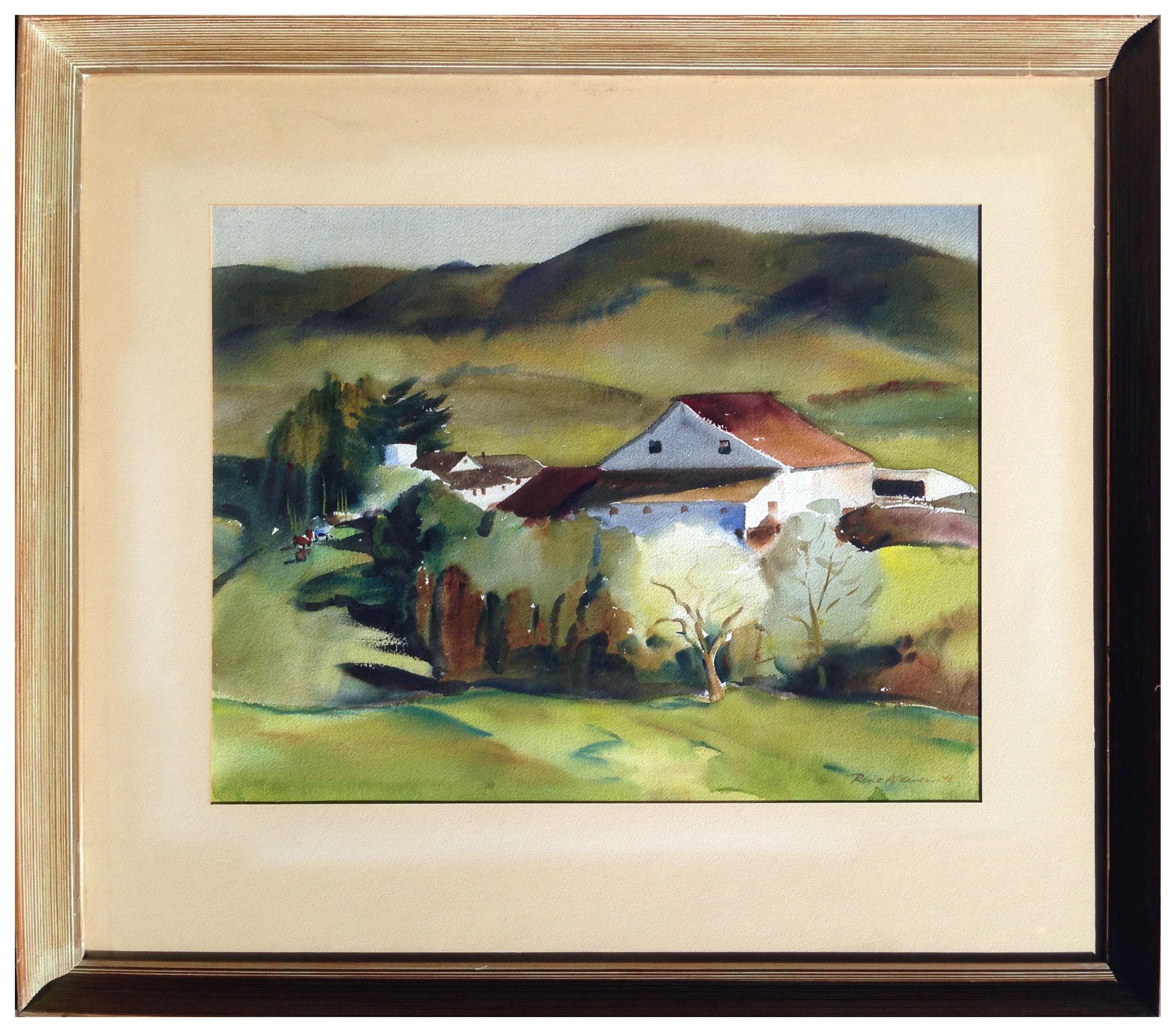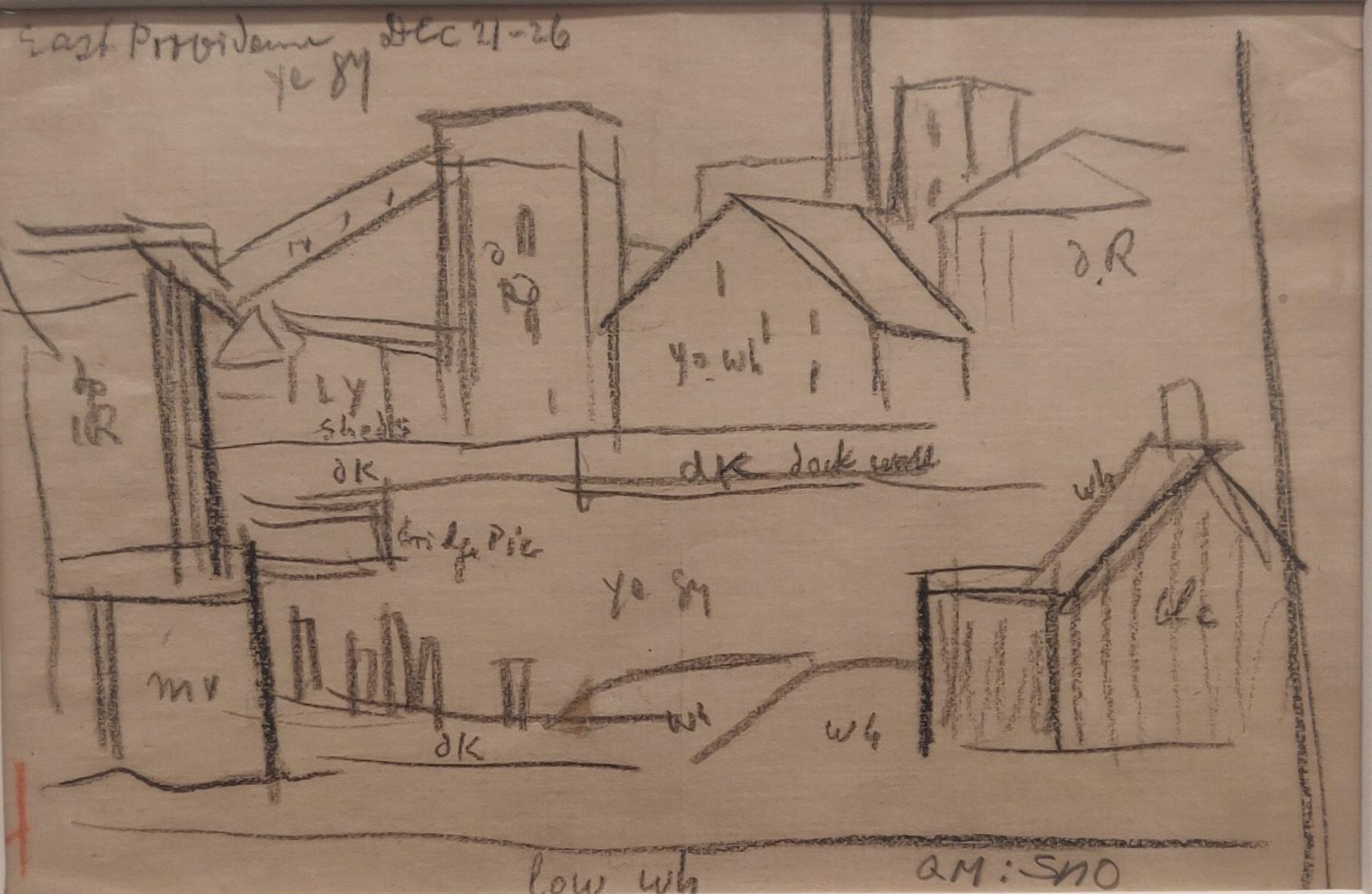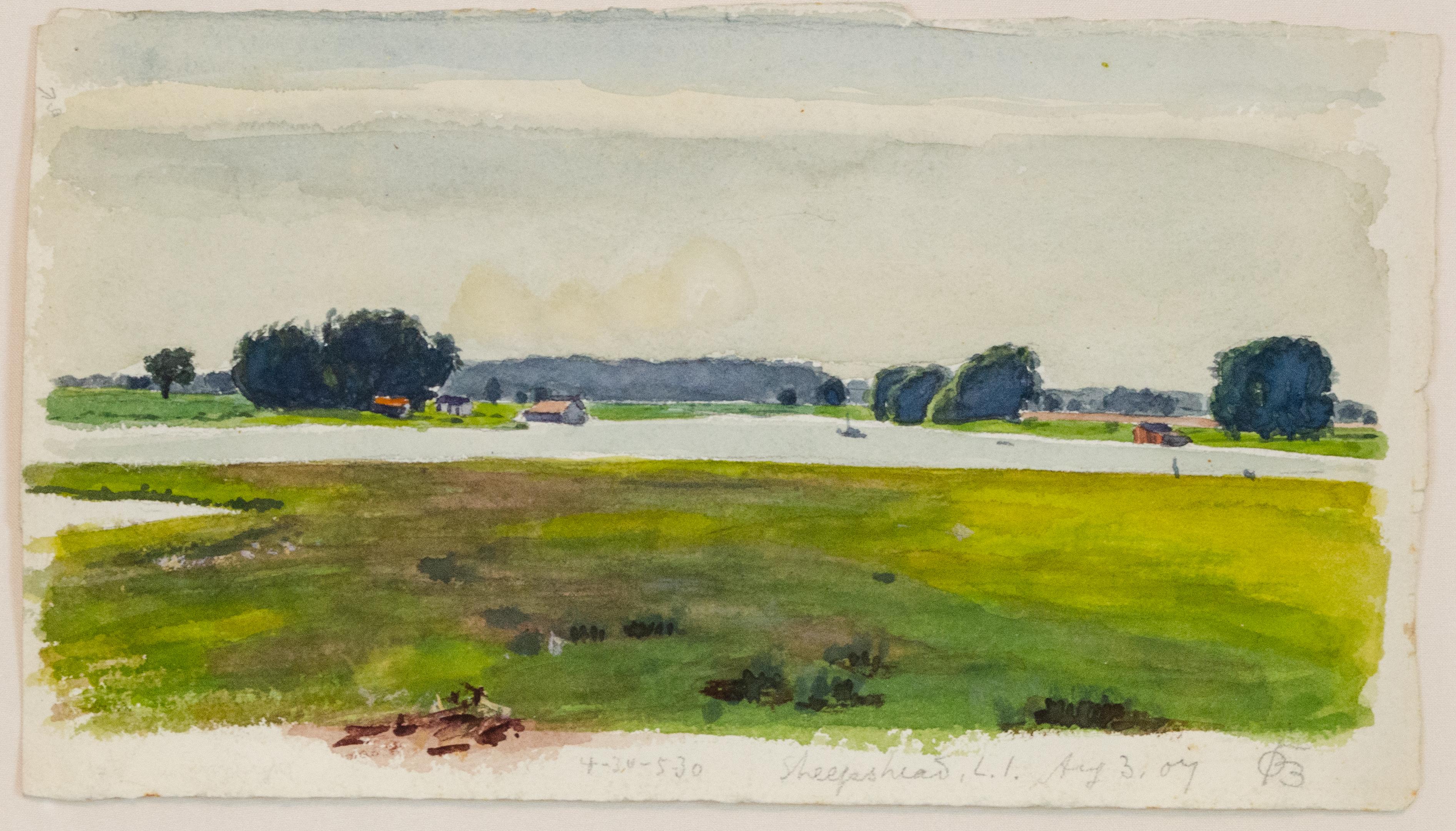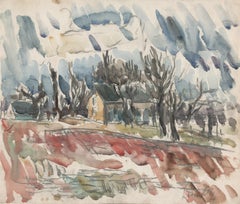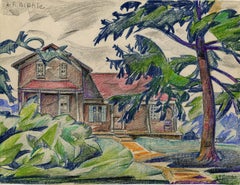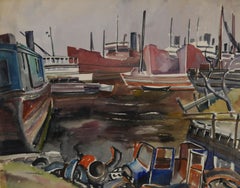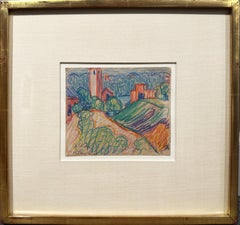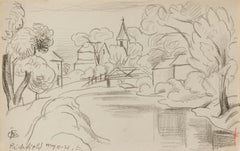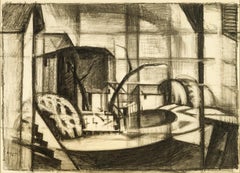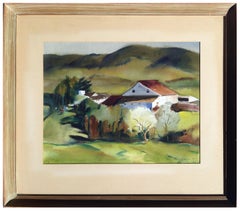Objekte ähnlich wie Brookdale, New Jersey
Möchten Sie mehr Bilder oder Videos?
Zusätzliche Bilder oder Videos von dem*der Anbieter*in anfordern
1 von 7
Oscar Florianus BluemnerBrookdale, New Jersey1922
1922
1.476,68 €
Versand
Angebot wird abgerufen …Das Versprechen von 1stDibs:
Authentizitätsgarantie,
Geld-Zurück-Garantie,
Stornierung innerhalb von 24 Stunden
Angaben zum Objekt
Brookdale, New Jersey
Graphit auf Papier, 1922
Signiert mit den Initialen des Künstlers l.l. und datiert 1922 (siehe Foto)
Vermerk "Brookdale" vorne und hinten auf dem Blatt
Zustand: Ausgezeichnet
Archivgerechte Rahmung mit 8 Lagen säurefreiem Lappenpassepartout und UV-Filterglas. Untergebracht in einem Eckrahmen mit Metallblättern im Marin-Stil
Rahmengröße: 15 x 16-3/8 x 3/4 Zoll
Bildgröße: 5 x 6 3/4 Zoll
Provenienz: Nachlass des Künstlers
Mit freundlicher Genehmigung von Wikipedia
Oscar Bluemner (21. Juni 1867 - 12. Januar 1938), geboren als Friedrich Julius Oskar Blümner und nach 1933 bekannt als Oscar Florianus Bluemner, war ein in Preußen geborener amerikanischer Maler der Moderne.
Frühes Leben
Blümner wurde am 21. Juni 1867 als Friedrich Julius Oskar Blümner in Prenzlau, Königreich Preußen (heute Deutschland), geboren. Er studierte Malerei und Architektur an der Königlichen Kunsthochschule in Berlin.
Architektur
Bluemner zog 1893 nach Chicago, wo er als freier Zeichner bei der Weltausstellung Columbian Exposition arbeitete. Nach der Ausstellung versuchte er, in Chicago Arbeit zu finden. Im Jahr 1901 zog er nach New York City, wo er ebenfalls keine feste Anstellung fand. 1903 entwarf er den Siegerentwurf für das Bronx Borough Courthouse in New York, der allerdings Michael J. Garvin zugeschrieben wird. Der damit verbundene Skandal führte zum Sturz des Gemeindepräsidenten Louis Haffen wegen Korruption und Betrug.
1908 lernte Bluemner Alfred Stieglitz kennen, der ihn mit den künstlerischen Innovationen der europäischen und amerikanischen Avantgarde bekannt machte. 1910 beschloss Bluemner, sich ganz der Malerei zu widmen und nicht mehr der Architektur.
Er stellte 1913 auf der Armory Show aus. Er sagte, dass der Beitrag der Amerikaner nicht mit dem der Europäer mithalten konnte, weil der amerikanische Auswahlprozess eher Rivalitäten und Kompromisse widerspiegelte als kuratorisches Urteilsvermögen, was zu einer "Melée von antagonistischen Beispielen" führte. 1915 gab ihm Stieglitz eine Einzelausstellung in seiner Galerie 291. Trotz der Teilnahme an mehreren Ausstellungen, darunter auch Einzelausstellungen, gelang es Bluemner in den folgenden zehn Jahren nicht, viele Bilder zu verkaufen, und er lebte mit seiner Familie in fast völliger Armut.
In den 1930er Jahren schuf er Gemälde für das Federal Arts Project.
Späteres Leben
Nach dem Tod seiner Frau im Jahr 1926 zog Bluemner nach South Braintree, Massachusetts. Von dort aus beteiligte er sich 1932 mit einem Brief an einer laufenden Debatte in der New York Times über die Frage "Was ist amerikanische Kunst?". Er schrieb:
"Amerika verkauft seine Schuhe, Maschinen, Rindfleischkonserven usw. in Europa und in der ganzen Welt nicht, weil sie einen amerikanischen Stil haben oder in die amerikanische Flagge gehüllt sind, sondern weil sie einfach am besten sind. So exportieren auch die Franzosen ihre Gemälde und Geburtenkontrolle, und die Deutschen exportieren Sauerkraut und Primadonnen, weil diese Dinge jeweils am besten sind. Für die Qualität bedeutet Nationalismus als Rassenattribut heute nichts mehr; Chemie, Astronomie oder Ingenieurwesen lassen nirgends eine nationale Note zu, ebenso wenig wie höhere Dinge wie Religion oder Philosophie.
Machen wir hier fortschrittliche und beste Malerei, jeder so, wie er es kann, und fragen nur: Was und wann ist Malerei im kritischen Sinne? ... Wie können sich die Menschen darüber einig sein, was ein amerikanischer Stil ist, wenn die Maler selbst und ihre Werke in der Frage, was wirkliche Malerei ist, zutiefst uneins sind! Und es gibt und gab schon immer nichts Verächtlicheres, Lächerlicheres und für die Kunst Verheerenderes als die Patriotisierung, die sich hinter dem Deckmantel der Profitmacherei verbirgt.
Im Idealfall ist die reine Kunst eine Sphäre und kein Land; die ersten wirklichen Künstler, immer und überall, waren entweder Importeure oder Immigranten, die das Licht mitbrachten. El Greco, ein Einwanderer ... trotzte den spanischen Professoren ...; wir bezeichnen sein Werk heute als wahrhaft spanischer als das seiner einheimischen Zeitgenossen. Und im gleichen Sinne wird die Zukunft es nicht versäumen, unser eigenes Werk als spezifisch amerikanisch zu bezeichnen, in das der hier lebende Maler keinen bewussten Gedanken an seine Herkunft aus Hoboken oder Kankakee und keine Rücksicht auf die reine und moderne Malerei und die höchste Qualität, zu der er vielleicht fähig ist, eingepflanzt hat."
Im Jahr 1935 hatte er eine erfolgreiche Einzelausstellung in der Marie Harriman Gallery in New York City. In der New York Times bezeichnete Edward ALDEN Jewell die Ausstellung als Bluemners "Apotheose". Er schrieb:
Er ist sehr lebendig und hat in letzter Zeit ... mit robusten [sic] Ergebnissen gearbeitet. Diese achtundzwanzig Gemälde tragen den allgemeinen Titel "New Landscape Paintings". Herr Blümner ist nämlich der Ansicht, dass ein gewisses Maß an "Repräsentation" unabdingbar ist, wenn abstrakte Ideen mit vollem Erfolg vermittelt werden sollen. Der Künstler bezeichnet sie jedoch umfassender und genauer als "Kompositionen für Farbthemen". Er könnte sie, wenn er wollte, sogar "Farbmusik" nennen, ohne die Schmach zu riskieren, die normalerweise mit Ausflügen in ein so gefährliches Gebiet einhergeht. ... Diese verblüffenden Bilder bilden Harmonien und Rhythmen, die in der Regel auf einfachen Aussagen beruhen. Hier gibt es keine der Ober- und Untertöne, die andere Künstler bei der Projektion von visueller Musik verwendet haben. Bluemner verlässt sich für seine Wirkung auf schlichte, klangvolle Akkorde. Obwohl Modulationen des Tons auftreten, scheinen diese in seinem Schema von untergeordneter Bedeutung zu sein. Dieser neue, kühne, ausrufende Stil hat es in sich.
Bluemner starb am 12. Januar 1938 durch Selbstmord.
Erbe
Die Universität Stetson besitzt mehr als 1.000 Werke von Oscar Bluemner, die ihm 1997 von seiner Tochter Vera Bluemner Kouba vermacht wurden. Im Jahr 2009 wurde das Homer and Dolly Hand Art Center in Stetson eröffnet, dessen Hauptaufgabe es ist, die Kouba Collection'S zu beherbergen und auszustellen. Zu Lebzeiten oft übersehen, wird Bluemner heute weithin als Schlüsselfigur bei der Entstehung der amerikanischen künstlerischen Moderne anerkannt, zusammen mit bekannteren Kollegen wie Georgia O'Keeffe und John Marin.
Im Jahr 2013 zeigte das Montclair Art Museum in New Jersey eine Ausstellung von Bluemners Werken, die Landschaften und Industriegebiete von Paterson darstellen und zwischen 1910 und 1917 entstanden sind und aus den Beständen von Stetson stammen. Es war der hundertste Jahrestag des Paterson-Seidenstreiks, der ihn zu seiner Politik inspiriert hatte.
Ein Ölgemälde von Bluemner, Illusion of a Prairie, New Jersey (Red Farm at Pochuck) (1915), wurde am 30. November 2011 bei Christie's, New York, für 5.346.500 $ verkauft.
- Schöpfer*in:Oscar Florianus Bluemner (1867-1938, Amerikanisch)
- Entstehungsjahr:1922
- Maße:Höhe: 12,7 cm (5 in)Breite: 17,15 cm (6,75 in)
- Medium:
- Bewegung und Stil:
- Zeitalter:
- Zustand:
- Galeriestandort:Fairlawn, OH
- Referenznummer:Anbieter*in: FA37421stDibs: LU14016412952
Anbieterinformationen
5,0
Anerkannte Anbieter*innen
Diese renommierten Anbieter*innen sind führend in der Branche und repräsentieren die höchste Klasse in Sachen Qualität und Design.
Gold-Anbieter*in
Premium-Anbieter*innen mit einer Bewertung über 4,3 und 24 Stunden Reaktionszeit
Gründungsjahr 1978
1stDibs-Anbieter*in seit 2013
798 Verkäufe auf 1stDibs
Typische Antwortzeit: <1 Stunde
Verbände
International Fine Print Dealers Association
- VersandAngebot wird abgerufen …Versand von: Akron, OH
- Rückgabebedingungen
Einige Inhalte dieser Seite wurden automatisch übersetzt. Daher kann 1stDibs nicht die Richtigkeit der Übersetzungen garantieren. Englisch ist die Standardsprache dieser Website.
Authentizitätsgarantie
Im unwahrscheinlichen Fall eines Problems mit der Echtheit eines Objekts kontaktieren Sie uns bitte innerhalb von 1 Jahr für eine volle Rückerstattung. DetailsGeld-Zurück-Garantie
Wenn Ihr Objekt nicht der Beschreibung entspricht, beim Transport beschädigt wurde oder nicht ankommt, kontaktieren Sie uns bitte innerhalb von 7 Tagen für eine vollständige Rückerstattung. DetailsStornierung innerhalb von 24 Stunden
Sie können Ihren Kauf jederzeit innerhalb von 24 Stunden stornieren, ohne jegliche Gründe dafür angeben zu müssen.Geprüfte Anbieter*innen
Unsere Anbieter*innen unterliegen strengen Dienstleistungs- und Qualitätsstandards, wodurch wir die Seriosität unserer Angebote gewährleisten können.Preisgarantie
Wenn Sie feststellen, dass ein*e Anbieter*in dasselbe Objekt anderswo zu einem niedrigeren Preis anbietet, werden wir den Preis entsprechend anpassen.Zuverlässige weltweite Lieferung
Unsere erstklassigen Versandunternehmen bieten spezielle Versandoptionen weltweit, einschließlich individueller Lieferung.Mehr von diesem*dieser Anbieter*in
Alle anzeigenLandscape with buildings and trees
Von Leon Kelly
Landschaft mit Gebäuden und Bäumen
Aquarell auf Papier, ca. 1930er Jahre
Signiert mit Bleistift unten rechts (siehe Foto)
Provenienz: Nachlass des Künstlers
Zustand: Ausgezeichnet
Bl...
Kategorie
1930er, Amerikanische Moderne, Landschaftszeichnungen und -aquarelle
Materialien
Wasserfarbe
York Road in der Nähe der Rt. 82
Von August F. Biehle
York Road in der Nähe der Rt. 82
Oben links mit Bleistift signiert; unten rechts nochmals mit grünem Bleistift signiert.
Raphit und Farbkreide auf Papier, auf Papier aufgezogen
c. 1...
Kategorie
Frühes 20. Jahrhundert, Fauvismus, Landschaftszeichnungen und -aquarelle
Materialien
Buntstift, Grafit
Hommage an Morandi
Von Phyllis Sloane
Hommage an Morandi
Aquarell, um 1990
Signiert unten rechts: Sloane
Ein wichtiges Aquarell des Künstlers in Ausstellungsgröße.
Von der Cleveland Clinic erworben, 2021 abgeschaltet
Zus...
Kategorie
1990er, Zeitgenössisch, Stillleben-Zeichnungen und -aquarelle
Materialien
Wasserfarbe
Staten Island
Von Robert Hallowell
Staten Island
Aquarell auf Papier, um 1928
Signiert mit dem Nachlassstempel unten links
Blattgröße: 19 1/8 x 23 7/8 Zoll
Verso betitelt
Teil einer kleinen Serie von Aquarellen des Ha...
Kategorie
1920er, Amerikanische Moderne, Landschaftszeichnungen und -aquarelle
Materialien
Wasserfarbe
Hinterhof II
Von Robert Kipniss
Hinterhof II
Lithographie, 1972
Signiert unten rechts
Signiert unten rechts
Mit Anmerkungen: Druckfahne
Aktenzeichen: Karl Lunde 58
Ein Abdruck befindet sich in der Sammlung des Art ...
Kategorie
1970er, Amerikanischer Realismus, Landschaftsdrucke
Materialien
Lithografie
Frühjahrs-Landschaft mit Haus und Figur
Von Louis Oscar Griffith
Frühjahrs-Landschaft mit Haus und Figur
Ein vorläufiges Aquarell für eine farbige Aquatinta, illustriert auf der Linie, Titel unbekannt
Signiert unten links in Druckbuchstaben (siehe...
Kategorie
1920er, Amerikanischer Impressionismus, Landschaftszeichnungen und -aqua...
Materialien
Wasserfarbe
Das könnte Ihnen auch gefallen
Belleville, NJ
Von Oscar Bluemner
Der Maler der Moderne Oscar Bluemner wurde 1867 in Hannover, Deutschland, geboren. Als junger Mann trat er in die Fußstapfen seines Vaters und Großvaters, die als Architekten tätig w...
Kategorie
Frühes 20. Jahrhundert, Amerikanische Moderne, Landschaftszeichnungen un...
Materialien
Papier, Kohlestift
Richfield
Von Oscar Bluemner
Außergewöhnlich seltene Skizze des amerikanischen Modernisten Oscar Bluemner. Sehr, sehr guter Zustand. Schön gerahmt.
Kategorie
Frühes 20. Jahrhundert, Amerikanische Moderne, Landschaftszeichnungen un...
Materialien
Kohlestift
Study for Old Canal, Red and Blue (Rockaway, Morris Canal)
Von Oscar Florianus Bluemner
Oscar Bluemner war ein Deutscher und ein Amerikaner, ein ausgebildeter Architekt, der sich intensiv mit Kunsttheorie, Farbtheorie und Philosophie beschäftigte, ein Autor von Kunstkri...
Kategorie
20. Jahrhundert, Amerikanische Moderne, Abstrakte Zeichnungen und Aquarelle
Materialien
Papier, Holzkohle
Landhauslandschaft aus der Mitte des Jahrhunderts
Von Rene Weaver
Lebhaftes Aquarell eines Landhauses und einer Baumgruppe in einer ländlichen Landschaft mit sanften grünen Hügeln und Bauernhoftieren in der Ferne, von dem kalifornischen Künstler Re...
Kategorie
1940er, Amerikanischer Impressionismus, Landschaftszeichnungen und -aqua...
Materialien
Papier, Wasserfarbe
Oscar Bluemner, „East Providence“, Zeichnung von East Providence, Architektur
Von Oscar Bluemner
Oscar Bluemner
East Providence, 21. Dezember 1926
Beschriftet mit Ort und Datum, oben links "East Providence Dec 21-26".
Schwarze Kreide auf Papier
5 x 7 7/8 Zoll
Julius Oskar Blüm...
Kategorie
Frühes 20. Jahrhundert, Moderne, Landschaftszeichnungen und -aquarelle
Materialien
Buntstift
Oscar Bluemner, Schafskopf, Brooklyn, Long Island“, modernistisches Aquarell
Von Oscar Bluemner
Oscar Bluemner
Sheepshead, Long Island, 1907
Signiert mit den zusammengesetzten Initialen des Künstlers "OB" und datiert "4-30 - 5 - 30" / "Aug 3, 07".
Aquarell auf Papier
6 x 10 Zol...
Kategorie
Frühes 20. Jhdt., Amerikanische Moderne, Landschaftszeichnungen und -aqu...
Materialien
Papier, Wasserfarbe
